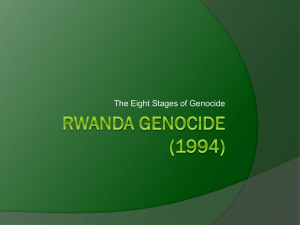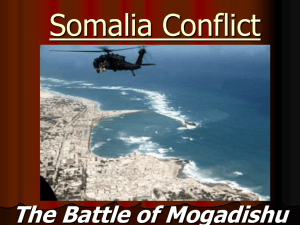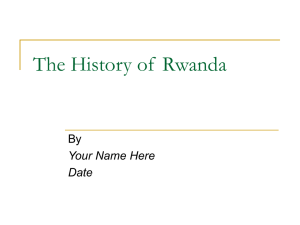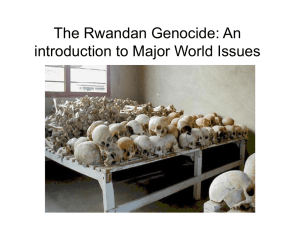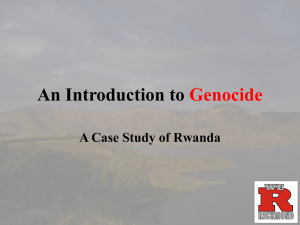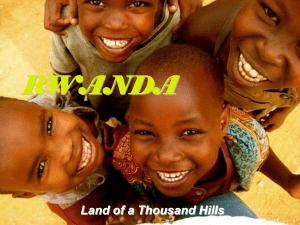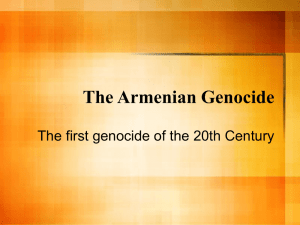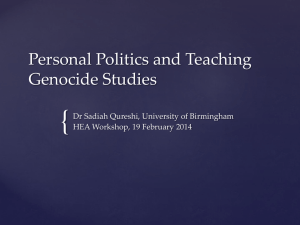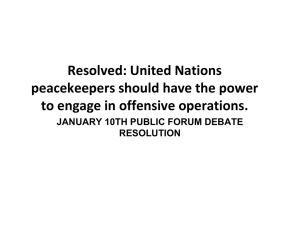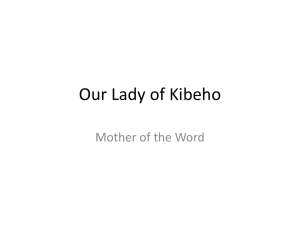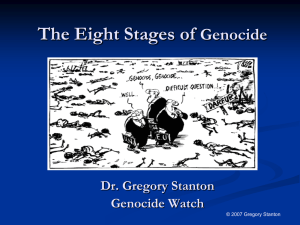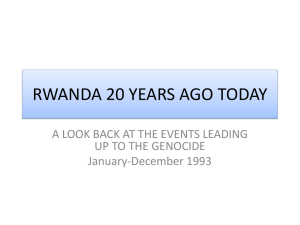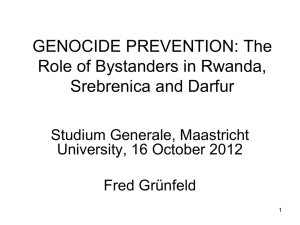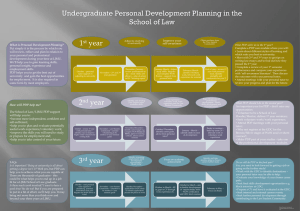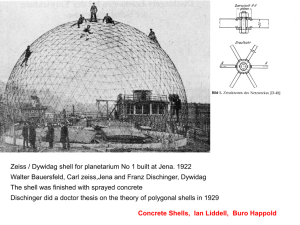GENOCIDE & THE MEDIA
advertisement
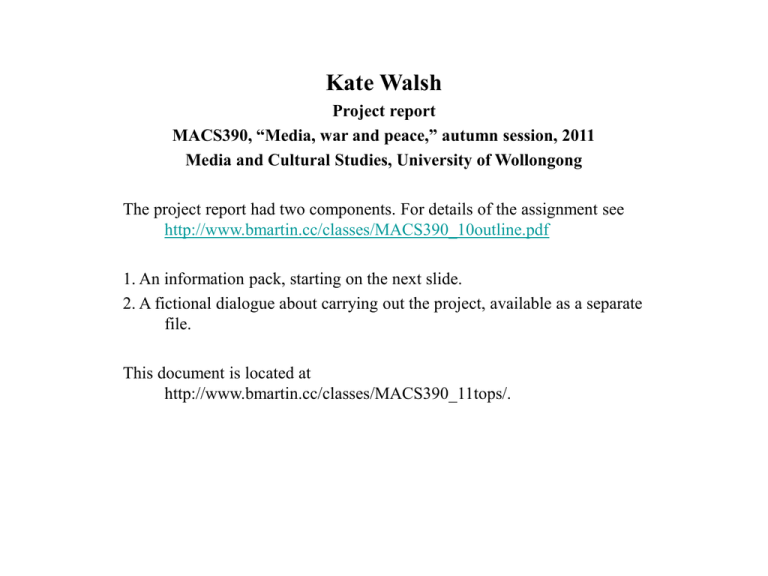
Kate Walsh Project report MACS390, “Media, war and peace,” autumn session, 2011 Media and Cultural Studies, University of Wollongong The project report had two components. For details of the assignment see http://www.bmartin.cc/classes/MACS390_10outline.pdf 1. An information pack, starting on the next slide. 2. A fictional dialogue about carrying out the project, available as a separate file. This document is located at http://www.bmartin.cc/classes/MACS390_11tops/. please be aware this presentation contains graphic images Student number 3450351. Tutor Ian Miles What is Genocide? • The 1948 United Nations Convention on the Prevention and Punishment of Genocide defines it as “any of the following acts committed with intent to destroy, in whole or in part, a national, ethnical, racial or religions group, as such: Killing members of the group; Causing serious bodily or mental harm to members of the group; Deliberately inflicting on the group conditions of life calculated to bring about its physical destruction in whole or in part; Imposing measures intended to prevent births within the group; Forcibly transferring children of the group to another group.” [1] This is the accepted international legal definition of genocide. Student number 3450351. Tutor Ian Miles 3 Genocide is… To simplify this definition “genocide is organised and unilateral mass killing on the basis of ethnicity.” [2] Student number 3450351. Tutor Ian Miles 4 The Rwandan Genocide • The Rwandan genocide occurred in 1994, when 800,000 [3] Tutsi peoples were killed by the Hutu peoples, the two main ethnic groups in Rwanda. Student number 3450351. Tutor Ian Miles 5 How did it Begin? There is no one reason the genocide began, rather it is due to many historical and social changes in Rwanda over more than 100 years. These include: • Tutsi formed the basis of the government, urged on by colonial rule, until the early 1960s, when a Hutu government came to power. After years of being portrayed and treated as inferior to the Tutsi, the Hutu used the distinctions already in place to demote the Tutsi to second class citizens. • During the 1970s, a massacre of Hutu by the Tutsi occurred in the neighbouring country of Burundi. Thousands of Hutu refugees came to Rwanda, while thousands of Tutsi left for neighbouring Uganda, altering number 3450351. Tutor 6 the power balanceStudent in Rwanda [4]. Ian Miles • As Tutsi began returning to Rwanda, the Rwandan Patriotic Front (RPF) was formed, carrying out acts of violence against the Hutu. From 1990, both groups were increasingly violent towards each other. • The organised killing of the Tutsi is widely acknowledged to have begun when President Habyarimana’s plane was shot down in April 1994 [5]. • The genocide officially ended on July 18, 1994. Student number 3450351. Tutor • Ian Miles 7 Student number 3450351. Tutor Ian Miles 8 Student number 3450351. Tutor Ian Miles 9 Student number 3450351. Tutor Ian Miles 10 Student number 3450351. Tutor Ian Miles 11 Theories of Genocide Genocide as Social Control - Bradley Campbell • This theory suggests genocide belongs to a part of social life that incorporates law and gossip, aspects of society that are used to control and manipulate. Campbell assumes that genocide is organised, lethal, unilateral and involves collective liability [6]. • Cultural distance must be present between the groups involved and society should be organised along “ethnic lines, where there is a higher degree of ethnic visibility”[7]. This creates unequal statuses between groups, convincing citizens one group is evil and must Studentto number 3450351. Tutor 12 be destroyed in order preserve the society. Ian Miles Theories of Genocide Genocide as Transgression – Dan Stone • Stone suggests that genocides stem from the creation of “ecstatic communities based on a radical form of social inclusion” [8], where societies need to use up their excess energy, releasing it as an act of catastrophic violence. • Tensions already within society reach their peak, urged on by the government’s validation of extreme actions, to the point where a collective euphoria results in an event that is a transgression from the normal functioning of society. Student number 3450351. Tutor Ian Miles 13 Genocide and the Media • Media can convince citizens to take part in acts of genocide, through the use of propaganda that draws on already established differences between groups. • For resistance groups and those that do not support the genocide, the media is also a crucial tool in drawing attention to their cause from more powerful allies. Student number 3450351. Tutor Ian Miles 14 • Radio Rwanda The majority of Hutu could not read or write, so radio played a crucial role in hate media against the Tutsi. • Radio Rwanda was first used for direct promotion of hate killings against the Tutsi in 1992. • The station consistently warned the Hutu that Tutsi were about to attack, and to take measures to protect themselves. • The station disbanded this singular message after an agreement was signed between the Rwandan government and But another station soon took over… Student number 3450351. Tutor 15 the RPF. Ian Miles Radio-Television Libre Des Milles Collines • This station started where Radio Rwanda left off, but connecting on a greater scale with the Hutu by playing current music and having a more upbeat tone. • The station gave sensationalised reports of the violence carried out on Hutu people by the Tutsi, referring to them as inyenzi: cockroaches. • “After April 6, (Habyarimana’s assassination), RTLM called on all Hutu to rise up as a single man to defend their country, in what was said to be the final war.”[9] Student number 3450351. Tutor 16 Ian Miles Karunga • Kangura was a popular bi-monthly newspaper that was well known for its hatred of both Tutsi and any Hutu who openly advocated for change. • This paper printed the Rwandan government’s infamous ‘Ten Commandments.’ Student number 3450351. Tutor Ian Miles 17 the ten commandments Student number 3450351. Tutor Ian Miles 18 Rwandan Media and Genocide Theory Genocide as Social Control In order to mobilise citizens against a common enemy, it is important to provide them with evidence, as the Rwandan media did. Through constantly portraying the Tutsi as “clannish, to have a disproportionate number of places in secondary and higher education, and to have infiltrated all aspects of Rwandan society”[10], the government was successfully able to mobilise the Hutu into action. By highlighting the supposed distance and differences between two groups, the Tutsi were victimised and thus targeted by ordinary civilians. Student number 3450351. Tutor Ian Miles 19 Rwandan Media and Genocide Theory Genocide as Transgression • Negative characterisation of the “other”, in this case the Tutsi, is also how regular people become transgressive, fighting against people who were once their neighbours and friends. As most Hutu held a lower position in society, or had risen from these positions, the Tutsi became a scapegoat for their problems, and the Hutu were mobilised by the media. Student number 3450351. Tutor Ian Miles 20 International Media Internationally, the media had little to say on the Rwanda genocide. Why? • Lack of understanding about the history. • Lack of resources in African nations. • Unwilling to send journalists due to danger and expense. • Government agenda setting: Particularly the US, who became involved in the Somalian conflict due to images portrayed by the media, and were unwilling to take the same actions again. Student number 3450351. Tutor Ian Miles 21 Avoiding the “G-Word” • Using the word “genocide” would require action from the United Nations [11]. • When the events in Rwanda were reported, international media avoided using the word “genocide”, terming it a “civil war” instead. This was at a detriment to the Rwandan people, as misreporting the genocide allowed it to continue without international intervention for longer than it should. • The first paper to use the word “genocide” was French paper Liberation, five days after it had begun[12]. The rest of the world followed suit two weeks later. Student number 3450351. Tutor Ian Miles 22 Without attention from the international media, the events of the Rwandan genocide remained largely unknown by the world. This highlights the importance of the media to report accurately and fairly, and to operate as a resource, not a business or arm of the government. Student number 3450351. Tutor Ian Miles 23 References • Convention on the Prevention and Punishment of the Crime of Genocide, Adopted by the General Assembly of the United Nation on 9 December 1948, available from http://untreaty.un.org/English/millennium/law/human_rights/iv_1E.wpd, accessed 01/06/11. • Campbell, C., 2009, ‘Genocide as Social Control,’ Sociological Theory, vol 27, no. 2, pp150-168. • Caplan, G, 2007, ‘Rwanda: Walking the Road to Genocide’ in A Thompson (ed), The Media and the Rwanda Genocide, Pluto Press, London, pp 20-39. • Chaon, A 2007, ‘Who Failed in the Genocide, Journalists or the Media?’ in A Thompson (ed), The Media and the Rwanda Genocide, Pluto Press, London, pp 160-166.. • Des Forges, A, 2007, ‘Call to Genocide: Radio in Rwanda 1994’ in A Thompson (ed), The Media and the Rwanda Genocide, Pluto Press, London, pp 41-54. Student number 3450351. Tutor Ian Miles 24 • Stanton, G. H., 2004, 'Could the Rwandan genocide have been prevented?', Journal of Genocide Research, vol 6, no. 2, pp 211-222 • Stone, D., 2004, ‘Genocide as Transgression,’ European Journal of Social Theory, vol 7, no. 45 pp 45-60. • Thompson, A, 2007, ‘Introduction’ in A Thompson (ed), The Media and the Rwanda Genocide, Pluto Press, London, pp 1-11 . • Uvin, P., 2001, ‘Reading the Rwandan Genocide’ International Studies Review, vol.3, no. 3, pp 75-99. Student number 3450351. Tutor Ian Miles 25 Images accessed from • Image 1 http://www.omanskligt.se/wp-content/uploads/2010/08/machete-rwanda.jpg • Image 2 http://www.state.gov/cms_images/soh_rwanda_5.jpg • Image 3 http://changeproduction.s3.amazonaws.com/photos/wordpress_copies/rwandagenocidekillingsdk0. jpg • Image 4http://4.bp.blogspot.com/_Qe1wgxDiEdU/TJSyzB0BiyI/AAAAAAAACLM/BNFpqvMo JbU/s1600/rwanda.church.jpg • Image 5http://thehumancondition.wikispaces.com/file/view/skull_of_victim_in_rwanda_genoc ide.jpg/146188515/skull_of_victim_in_rwanda_genocide.jpg Student number 3450351. Tutor Ian Miles 26 • Image 6http://beta.images.theglobeandmail.com/archive/00357/Rwanda_g enocide__357361artw.jpg • Image 7 http://www.iitaly.org/files/imagecache/545x/files/still_photos/Genocide%20_susp ect_1255250932.jpg • Image 8http://filipspagnoli.files.wordpress.com/2008/07/tutsicockroaches.jpg • Image 9http://3.bp.blogspot.com/_pCXi6k0Szc/THPyozUSizI/AAAAAAAAWGA/OEGzF_iuhrs/s640/Hutu +Ten+Commandments+-+Wikipedia,+the+free+encyclopedia++Mozilla+Firefox.png • Image10 • http://image.shutterstock.com/display_pic_with_logo/151882/151882 ,1270625080,12/stock-vector-april-day-of-reflection-on-thegenocide-in-rwanda-50390086.jpg Student number 3450351. Tutor Ian Miles 27

